A changing workforce, global competition, advances in information technology, new knowledge, an uneven recovery from the 2008 global recession, demands for sustainable organizational performance, and a host of other changes are forcing organizations to constantly examine and reevaluate how they operate. They are using new technologies, changing their structures, redesigning work, relocating their workforces, and improving work processes to respond to an increasingly demanding, unpredictable, and global competitive environment (Lawler and Worley 2011). These important changes have significant implications for how their human capital should be managed and how their human resource functions should be designed and operated. But are organizations changing their human capital management policies, practices and processes? Are they redesigning their HR functions?
Over the past decade, it has been difficult to find a management book or business magazine that does not point out how many of the changes in the business world have made human capital—people—an organization’s most important asset. Human capital management has been the focus of a great deal of writing focused on finding, motivating, developing, and monitoring the right talent. The annual reports of many corporations in North America, Europe, and Australia argue that their human capital and intellectual property are their most important assets. In many organizations, compensation is one of the largest costs, if not the largest one. In service organizations, it often represents 70 to 80 percent of the total cost of doing business. Adding the costs of training and other HR management activities to compensation costs means that the HR function often has the responsibility for a very large and growing portion of an organization’s total expenditures.
In most organizations, the compensation cost of human capital is not the only, or even the most, important determinant of an organization’s effectiveness. Even when compensation accounts for very little of the cost of doing business, human capital has a significant impact on the performance of most organizations (Cascio 2000; Cascio and Boudreau 2011). In essence, without effective human capital, organizations are likely to have little or no revenue. Even the most automated production facilities require skilled, motivated employees to operate them. Knowledge work organizations depend on employees to develop, use, and manage their most important asset, knowledge. Thus, although human capital does not appear on the balance sheet of corporations, it represents an increasingly large percentage of many organizations’ market valuation (Lev 2001; Huselid, Becker, and Beatty 2005).
In an increasing number of organizations, having the best talent and talent management processes can be a continuous, difference-making source of competitive advantage. It can make companies more innovative and agile, better able to develop superior products and customer knowledge, and offer superior services (Worley, Williams, and Lawler, 2014).
Role of the HR Organization
Because of the way the business environment has changed, there are more and more ways the HR function can add value to an organization. For decades, it has added value primarily by performing administrative tasks. But two other roles that it can play allow it to add greater value. Lawler (1995) has developed this line of thought by describing three roles HR can take on. The first is the familiar HR management role (exhibit 1.1).
The second is the role of business partner (exhibit 1.2). It emphasizes developing systems and practices to ensure that a company’s human resources have the needed competencies and motivation to perform effectively. In this approach, HR has a seat at the table when business issues are discussed and brings an HR perspective to these discussions. When it comes to designing HR systems and practices, this approach focuses on creating systems and practices that support the business strategy. HR focuses on the effectiveness of the human capital management practices and process improvements in them. HR is expected to help implement changes and help managers effectively deal with people issues.
The business partner approach positions the HR function as a value-added part of an organization so that it can contribute to business performance by effectively managing what is the most important capital of most organizations, their human capital (Ulrich and Brockbank 2005; Lawler 2008). But this approach may not be one that enables the HR function to add the greatest value given the increasingly important role that talent plays in determining organizational performance. By becoming a strategic contributor (see exhibit 1.3), HR has the potential to add more value in situations where human capital performance can be a major difference maker.
Acting as a strategic contributor means that HR plays a role that includes helping the organization develop its strategy. Not only does HR have a seat at the strategy table, it helps to set the table with information about organizational capabilities, talent analytics, and the labor market. It helps shape and enhance strategies by bringing human capital decision science to strategy discussions. It helps organizations operate in ways that help it perform well financially, socially, and environmentally.
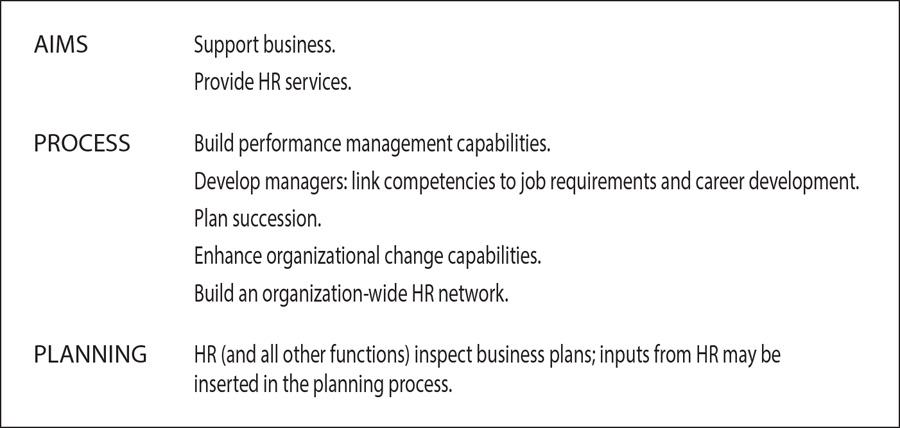
Exhibit 1.1. HR management

Exhibit 1.2. Business partner
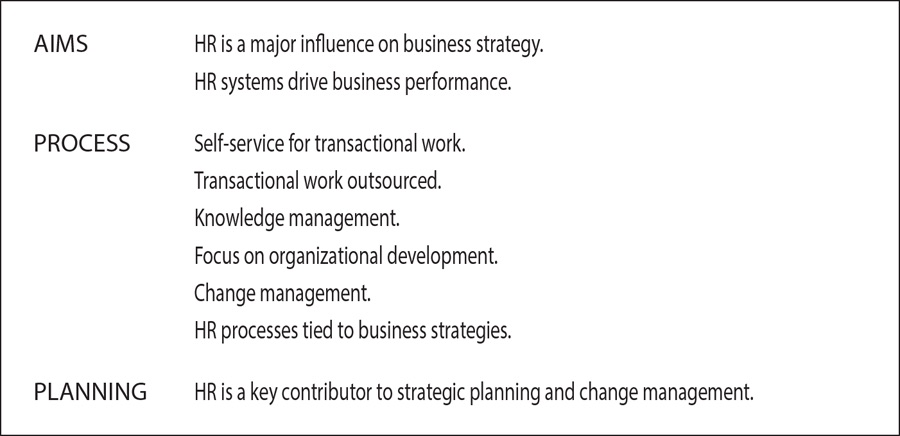
Exhibit 1.3. Strategic contributor
In a knowledge business, a firm’s strategy must be closely linked to its talent. Thus, the HR function needs to be positioned to play a major role in both strategy formulation and implementation. Expertise in attracting, retaining, developing, deploying, motivating, and organizing human capital is critical to both. Ideally the HR function should be knowledgeable not just about the business and about talent; it should also be the expert in organizational and work design issues so that it can help develop needed organizational capabilities and facilitate organizational change.
To be a strategic contributor, HR executives need, in addition to knowing HR, an expert understanding of business strategy, organizational design, and change management, and they need to know how integrated HR practices and strategies can support organizational designs and strategies. This role requires extending their focus beyond delivery of the HR services and practices that are associated with being a business partner to a focus on making decisions about talent, organizational design, and business strategy.
To be an effective strategic contributor, HR needs to offer a perspective that is often missing in discussions of business strategy and change: knowledge of the human capital factors and the organizational changes that are critical in determining whether a strategy can be implemented. Many more strategies fail in execution than in their conception (Lawler and Worley 2006). What sounds good often cannot be implemented for a variety of reasons having to do with talent management and organizational culture.
Despite compelling arguments supporting HR management as a key strategic issue in most organizations, our research and that of others finds that HR executives usually are not strategic contributors and do not use data to guide their decision making (Lawler 1995; Brockbank 1999; Lawler, Boudreau, and Mohrman 2006; Lawler and Boudreau 2009, 2012). All too often, HR is largely an administrative function headed by individuals whose roles are focused on cost control and administrative activities (Ulrich 1997; Lawler and Mohrman 2003; Boudreau and Ramstad 2005a; Lawler and Boudreau 2009, 2012). Missing almost entirely from the list of HR focuses in our 2010 global survey of HR in large corporations were such key organizational challenges as improving productivity, increasing quality, facilitating mergers and acquisitions, managing knowledge, implementing change, developing business strategies, and improving the ability of the organization to execute strategies (Lawler and Boudreau 2012). Since these areas are critical determinants of organizational performance, the HR function was missing a great opportunity to add value.
There is some evidence that the HR function is beginning to redefine its role in order to increase the value it adds. The first six phases of the study collected data in 1995, 1998, 2001, 2004, 2007, and 2010. The results showed evidence of some change in large US corporations, but there was more discussion of change than actual change (Lawler and Mohrman 2003; Lawler et al., 2006; Lawler and Boudreau 2009, 2012). In addition, there is evidence of change in the profession. The leading professional association for HR, SHRM, has grown to over 270,000 members. Until 1984, SHRM was known as the American Society for Personnel Administration, a name that reflected HR’s administrative role in organizations. Nevertheless, although it has changed its name, it still is more focused on personnel administration than on talent management and business strategy.
Creating Change
Describing the new role of HR is only the first step in transitioning the HR function to be a business partner that contributes to organizational effectiveness. For decades, the HR function has been organized and staffed to carry out administrative activities. Changing that role will require a different mix of activities and people. It will necessitate reconfiguring the HR function to support changing business strategies and organizational designs. It also will require the employees in the HR function to have very different competencies from those they traditionally have had (Ulrich, Younger, Brockbank, and Ulrich 2012).
It is clear that information technology is playing an increasingly important role in the future of the HR function (Lawler, Ulrich, Fitz-enz, and Madden 2004; Boudreau 2010). Administrative tasks that have been traditionally performed by the HR function can be done by employees and managers on a self-service basis. Today’s HR information systems (HRIS) simplify and speed up virtually every administrative HR task: salary administration, job posting and placement, address changes, family changes, and benefits administration, for example. What is more, HR systems are available around the clock, and with mobile technology, they can be accessed from virtually anywhere by anyone, thus making self-service possible, convenient, and efficient.
Perhaps the greatest value of HRIS results from enabling the integration and analysis of HR activities, thus guiding strategy development and implementation. Metrics can be easily tracked and analyses performed that make it possible for organizations to develop and allocate their human capital more effectively (Boudreau and Ramstad 2007; Lawler, Levenson, and Boudreau 2004).
It is increasingly possible to measure and analyze the effectiveness of many HR policies and practices. With big data and a strategic mind-set, HR can be a data-driven function that practices evidence-based management. Business leaders can now be held accountable for HR measures such as turnover, employee attitudes, bench strength, and performance distributions.
A strong case can be made that HR needs to develop much better metrics and analytics capabilities. Our previous six studies identified metrics as one of four characteristics of HR systems that lead to HR’s being a strategic partner. Managers want measurement systems that inform their decisions about human capital. All too often, however, HR focuses on the traditional paradigm of delivering HR services quickly, cheaply, and in ways that satisfy their clients but fail to use HR measures to make a true strategic difference in an organization’s performance (Boudreau and Ramstad 1997, 2003). The issue is how to use HR measures to make a true strategic difference in an organization’s performance.
Boudreau and Ramstad (2007) have identified four critical components of a measurement system that drive strategic change and organizational effectiveness: logic, analysis, measures, and process. Measures certainly are essential, but without the other three components, they are destined to remain isolated from the true purpose of the HR measurement systems.
Boudreau and Ramstad (1997) have also proposed that HR can make great strides by learning how more mature and powerful decision sciences have evolved their measurement systems in order to improve decision making. They identify three anchor points—efficiency, effectiveness, and impact—that connect decisions about resources such as money and customers to organizational effectiveness and that can be used to understand HR measurement:
1. Efficiency asks, “What resources are used to produce our HR policies and practices?” Typical indicators are cost-per-hire and time-to-fill vacancies.
2. Effectiveness asks, “How do our HR policies and practices affect the talent pools and organizational structures to which they are directed?” It thus refers to the effects of HR policies and practices on human capacity (a combination of capability, opportunity and motivation) and the resulting aligned actions of the target talent pools. Effectiveness includes trainees’ increased knowledge, better-selected applicants, stronger qualifications, and performance ratings of those receiving incentives.
3. Impact poses the hardest question of the three: “How do differences in the quality or availability of different talent pools affect strategic success?” This question is a component of talent segmentation, just like market segmentation is for marketers: “How do differences in the buying behavior of different customer groups affect strategic success?”
Most HR measurement systems largely reflect the question of efficiency, though there is some attention to effectiveness as well through focusing on such things as turnover, attitudes and bench strength (Gates 2004). Rarely do organizations consider impact (such as the relative effect of different talent pools on organizational effectiveness). More important, it is rare that HR measurement is specifically directed toward where it is most likely to have the greatest effect: on key talent. Attention to nonfinancial outcomes and sustainability also needs to be increased, as strategic HR can affect these as well (Boudreau and Ramstad 2005a).
The Emerging HR Decision Science
The majority of HR practices, benchmarks, and measures still reflect the traditional HR paradigm of excellence, defined as delivering high-quality HR services in response to client needs. Even as the field advocates more strategic HR, it is often defined as delivering the HR services that are important to executive clients: leadership development, competency systems, board governance, and so on. But this traditional service delivery paradigm is fundamentally limited because it assumes that clients know what they need. Market-based HR and accountability for business results should also be recognized as important (Gubman 2004). However, all too often, they amount to merely using marketing techniques or business results to assess the popularity of traditional HR services and their association with financial outcomes.
Fields such as finance have a different approach. They have augmented their service delivery paradigm with a decision science paradigm that teaches clients the frameworks to make good choices. Significant improvements in HR decisions will be attained not by applying finance and accounting formulas to HR programs and processes, but by learning how these fields evolved into the powerful, decision-supporting functions they are today. Their evolution provides a blueprint for what should be next for HR. The answer lies not just in benchmarking HR in other organizations, but in evolving to be similar to more strategic functions such as finance and marketing.
In marketing, decision science informs decisions about customers. In finance, decision science informs decisions about money. In human capital, a decision science should inform decisions about organizational talent and decisions made both within and outside the HR function. Boudreau and Ramstad (2005a, 2007) have labeled this emerging decision science “talentship” because it focuses on decisions that improve the stewardship of the hidden and apparent talents of current and potential employees.
Strategic Focuses
Human resource organizations exist in organizational environments that are as turbulent as the competitive environments in which companies find themselves. As companies take measures to survive and prosper, they make changes and introduce strategic initiatives that change the organization, the competencies it has, the way it manages its human resources, and its expectations of and relationships to its employees (Boudreau and Jesuthasan 2011; Lawler and Worley 2011).
A key driver of an organization’s approach to organizing and performing is its business strategy. Thus, in order to understand how the HR function operates and what makes it effective, it is important to examine how its characteristics are related to the strategic focuses of the organization in which it operates. We have done this in our past studies and do it in this study as well.
Table 1.1 shows the prevalence of five strategic focuses that are often part of a company’s business strategy. It also shows that in our US sample, the items measuring strategic focus statistically factor into five types: growth, information, knowledge, sustainability, and innovation. The focus concerned with information was rated the highest strategy in 1998, and the item on customer focus was the most highly rated single item. There are a few significant differences in the data from the different surveys. However, there is no overall trend that shows some focuses consistently increasing and others decreasing. Instead the results suggest that the focuses vary in importance based on what is happening during a particular time period.
Table 1.2 presents the strategic focus data for each country in our study. Building a global presence is the focus that shows the largest differences. The European and India companies have the greatest focus on it and China the least. China is the country that is the most different, with the lowest ratings across the board. This is not surprising given that it is less developed than the other countries and does not have a history of capitalism with its focus on competitive strategies.
Table 1.1. Strategic focuses, United States
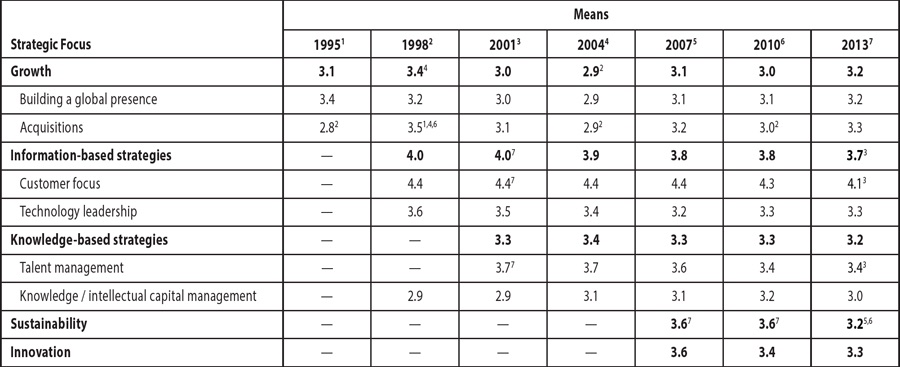
Response scale: 1 = little or no extent; 2 = some extent; 3 = moderate extent; 4 = great extent; 5 = very great extent. Empty cells indicate that the item was not asked in that year.
Significant differences between years (p ≤ .05).
Table 1.2. Strategic focuses, by country
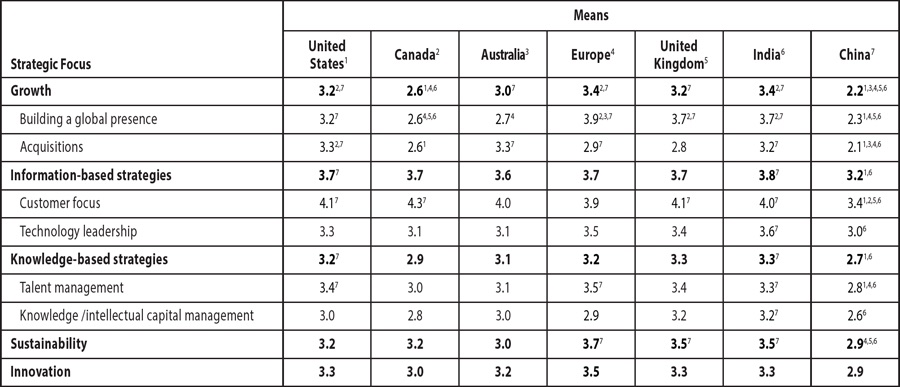
Response scale: 1 = little or no extent; 2 = some extent; 3 = moderate extent; 4 = great extent; 5 = very great extent.
Significant differences between countries (p ≤ .05).
The highest-rated focus in every country is customer focus. Also highly rated is talent management. The high ratings for these two strategic focuses are an important point with respect to the role HR plays in strategy formulation and implementation. Given the close tie between them and HR policies and practices, it is logical that HR should play a major role in strategy development and implementation.
On balance, the strategic focus data support the point that organizations exist in complex, dynamic environments and need a variety of strategic and organizational initiatives to position themselves to perform successfully. In order to add value and act as a strategic contributor, the HR function needs to help ensure that the organizational capabilities and competencies exist to cope with a dynamic environment and changing organizational focuses. It is important to look at how the HR function is performing and changing, as well as how it is being driven by companies’ strategies.
Management Approaches
The management approach that organizations take varies widely and should influence what the HR function can and should do. In the 2007, 2010, and 2012 surveys, we asked the respondents how much their company used these five management approaches:
• Bureaucratic: hierarchical structure, tight job description, top-down decision making
• Low-cost operator: low wages, minimum benefits, focus on cost reduction and controls
• High involvement: flat structure, participative decisions, commitment to employee development and careers
• Global competitor: complex, interesting work, best talent, low commitment to employee development and careers
• Sustainable: agile design, focus on financial performance and sustainability
The first four of these approaches are described in more detail in O’Toole and Lawler (2006). The fifth, sustainable management, is fully described by Lawler and Worley (2011). As can be seen in table 1.3, sustainable management is the most frequently used in the US companies studied. The second most frequently used is global competitor, which is also the only one that is used more often in 2013 than in 2007. These results most likely are due to changes in the business environment as more and more organizations are competing globally and experiencing demands for sustainable performance.
The results from our international sample, shown in table 1.4, are similar to the US results: the sustainable approach is used the most by the companies in our international sample, and the low-cost-operator approach is used the least.
The noticeable outlier is China. As it did in 2010, it uses the low-cost-operator and bureaucratic approaches the most and the high-involvement approach the least in comparison to the other countries. It also is a relatively low user of the global competitor approach. The most obvious explanation for the tendency of China to use different management approaches is its level of economic and management development.
Table 1.3. Management approaches, United States
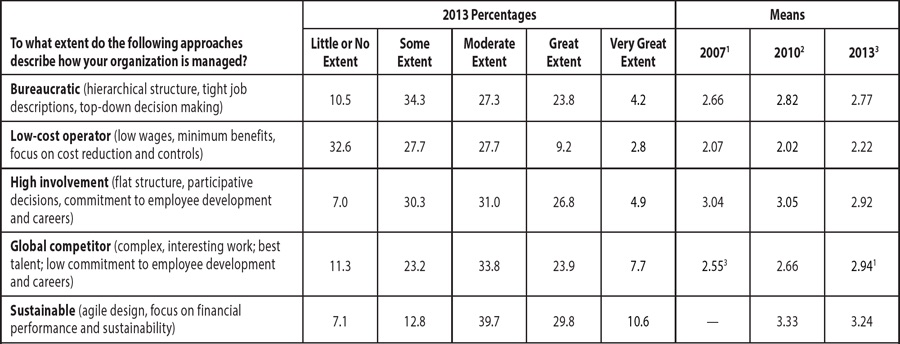
Note: The empty cell signifies that the item was not asked in that year.
Significant differences between years (p ≤ .05).
Table 1.4. Management approaches, by country
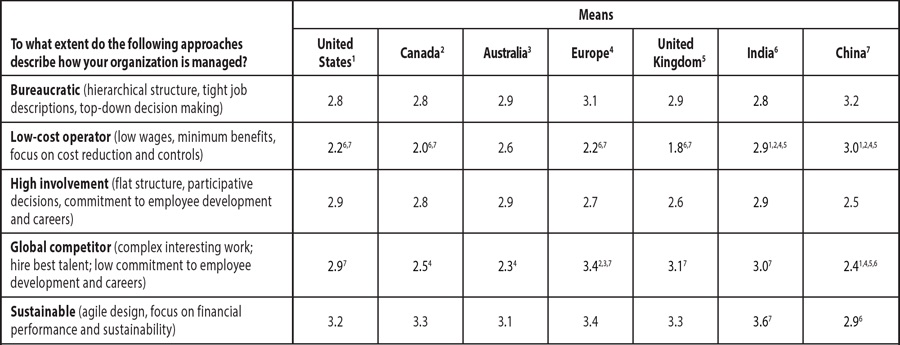
Response scale: 1 = little or no extent; 2 = some extent; 3 = moderate extent; 4 = great extent; 5 = very great extent.
Significant differences between countries (p ≤ .05).
Throughout this book, we look at how US corporations that use these five approaches operate. They do not include all possible management approaches, and we do not expect that any company will be managed in one way. We use them because they provide a way to identify the overall management approach that a large corporation is taking and how HR practices are related to the way a company is managed.
Organizational Design
Organizational design is a key factor in enabling organizations to develop capabilities and perform in ways that produce a competitive advantage (Galbraith 2014). Organizational design is more than structure; it includes elements such as management processes, rewards, people systems, information systems, and work processes. These elements must fit with the strategy and with each other for an organization to perform effectively.
Organizational designs involve complex trade-offs and contingencies. Clearly no single design approach fits all organizations. As new business models emerge—complex partnerships, globally integrated firms, customer-focused designs, and network organizations—new approaches and organizational forms need to be created to deal with the complex performance requirements that organizations must address. Furthermore, multibusiness corporations are recognizing that different businesses exist in different markets and face varying requirements. Consequently, variation in organizational design is increasing both within multibusiness corporations and between businesses (Galbraith 2014). Thus, for the company and the HR function, one size does not fit all situations. Different organizational forms require different HR contributions, and thus different HR functional designs and systems.
Contributing to effective organizational design is a major domain in which the HR function has the opportunity to add strategic value (Lawler 2008). Increasingly, the only sustainable competitive advantage is the ability to organize effectively, respond to change, and manage well (Mohrman, Galbraith, Lawler, and Associates 1998; Lawler and Worley 2006; Worley et al. 2014). Confirmation of this statement is provided by Lawler, Mohrman, and Benson’s (2001) longitudinal study of the Fortune 1000, which shows a significant relationship between firm financial performance and the adoption of new management practices designed to increase a firm’s capabilities. Further confirmation of this is provided by data showing that agile firms outperform all others over the long term. (Worley et al. 2014).
Lawler (2008) has identified four approaches to talent management that need to be supported by different organizational designs and HR practices. For example, the low-cost-operator approach calls for an organizational design that has highly structured jobs and excellent control systems. The high-involvement and the global competitor approaches require interesting, challenging jobs as well as flat structures that put people in contact with the external environment. The fourth approach, sustainable management, calls for a focus on how an organization affects the environment, society, and its employees. Both picking the right approach to management and then implementing it effectively are opportunities for the HR function to add significant value.
Design of the HR Function
All parts of organizations—operating units and staff functions alike—need to be designed to deliver high value. For staff groups, doing so requires the development of a business model—a value proposition defining what kind of value they will deliver that the company is willing to pay for because their work strengthens company performance. It also requires them to determine how best to deliver their services.
The HR function must think about whether the elements of its design indeed create a high-performance organization—one capable of delivering maximum value while consuming the fewest possible resources. Doing so means concentrating on the way HR organizes to deliver routine transactions services, traditional HR systems development and administration, and strategic business support.
HR must develop structures, competencies, customer linkages, metrics, management processes, rewards, and information technology to ensure that scarce resources are optimally deployed to deliver value. In addition to making sure the HR function is optimally designed, HR can add value by helping design the key features of the rest of the organization.
In many respects, it is useful to think of HR functions as multiple product businesses. They have customers, products and services, revenue, and competitors (self-service, vendors, and consulting firms). In order to exist, they need to perform in a way that makes them the “best buy.”
Organizational design decisions for HR, as well as for companies as a whole, are made in response to four key questions:
1. Which activities should be centralized and leveraged, and which should be decentralized in order to provide focus on the unique needs of different parts of the organization? Organizations are combining centralization and decentralization, trying to be big (coordinated) in functions such as purchasing when there is an advantage to being big and small (decentralized and flexible) in functions such as new product development when there are advantages to being small and agile.
2. Which functions should be performed in-house and which should be outsourced? Companies should outsource when they can purchase high-quality services and products more inexpensively or reliably than they can generate internally.
3. Which functions should be hierarchically controlled, and which should be integrated and controlled laterally? In some areas, organizations function in a lateral manner, integrating and creating synergies across various parts of the organization, creating cross-functional units to carry out entire processes, and collaborating with suppliers and customers. Organizations are searching for ways to leverage across business units while setting up organizational and management approaches that give the optimal levels of flexibility and control to various business units.
4. Which processes should be IT based? Today most organizations have electronic systems that can do a great deal of the administrative work of HR, but what is it advantageous to have them do?
Traditionally HR (and many other staff groups such as IT) has been organized in a hierarchical manner, and it has seen its mission as designing, administering, and enforcing adherence to HR policies and systems. As a result, all too often HR has been seen as an expensive and necessary evil that consumes resources disproportionate to the value that it adds to the organization. A number of changes in structure and process are being advocated for HR:
• Decentralizing business support to operating units in order to increase responsiveness
• Contracting with business units for the services that are to be delivered, and perhaps even requiring services to be self-funding as a way of ensuring that businesses get only the services that they are willing to pay for and that they see as contributing to business performance
• Creating efficient central services units or outsourcing transactional services, or both
• Creating centers of excellence that provide expert services, often in a consulting capacity
• Increasing the rotation of people within various staff functions and between staff and line, and having fewer lifelong careers within a narrow staff function, in order to broaden the perspectives of HR staff professionals and increase their awareness of business issues, as well as increasing the depth of understanding of HR issues among line management
• Expanding the scope of the HR function to include communications and sustainability, to mention just two areas
Conclusion
The future of the HR function in organizations is uncertain. On the one hand, if it does not change, it could end up being largely an administrative function that manages an information technology–based HR system and vendors who do most of the HR administrative work. On the other hand, it could become a driver of organizational effectiveness and business strategy. In many organizations, one of the key determinants of competitive advantage is effective human capital management. More than ever before, the effectiveness of an organization depends on its ability to address issues such as knowledge management, change management, and capability building, all of which could fall into the domain of the HR function. The unanswered question at this point is whether HR will rise to the occasion and address these issues.
In order to increase its contribution to organizational effectiveness, HR must rethink its basic value proposition, structure, services, and programs in order to address how it can add value in today’s economy with new organizational forms, business strategies, and performance demands. HR faces a formidable challenge in helping organizations deal with the human issues that are raised by large-scale strategic change. To deal with these challenges effectively, HR has to focus on how it is organized and its competencies and role in business strategy.
There is some evidence that the situation of HR is changing and that the function is beginning to redefine its role in order to increase the value it adds. Data collected in 1995, 1998, 2001, 2004, 2007, and 2010 found evidence of some change in large US corporations, but there has been more talk of change than actual change (Lawler and Mohrman 2003; Lawler et al. 2006; Lawler and Boudreau 2009, 2012). If this is true in the 2013 results examined in this book, it will be additional evidence that HR is not doing what it needs to do in order to be a key contributor to organizational effectiveness.